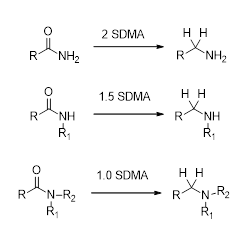Reducing effects
Reducing potential is the most important industrially applicable benefit of Synhydrid®. Its reducing abilities are used or can be used in many various syntheses of organic compounds. Whatever can Synhydrid® reduce?
Reducing potential is the most important industrially applicable benefit of Synhydrid®. Its reducing abilities are used or can be used in many various syntheses of organic compounds. Whatever can Synhydrid® reduce?

Reduction of aldehydes
Smooth reduction of aldehydes with Synhydrid® gives almost quantitative yields of the corresponding alcohols. The reaction requires 1 mole of SDMA per 2 moles of the aldehyde:
2 RCH=O + NaAlH2(OCH2CH2OCH3)2 = NaAl(OCH2R)2(OCH2CH2OCH3)2
Reduction of ketones
Reduction of ketones with Synhydrid® is very rapid and practically quantitative yields of corresponding secondary alcohols can be obtained with exception of highly sterically hindered ketones. The stoichiometry of the reduction requires 0.5 mole of the hydride per 1 mole of the ketone:
2 R1COR2 + NaAlH2(OCH2CH2OCH3)2 = NaAl(OCHR1R2)2(OCH2CH2OCH3)2
Reduction of organic halides
Synhydrid® can reduce organic halides to corresponding hydrocarbons:
2 RX + NaAlH2(OCH2CH2OCH3)2 = 2 RH + NaAlX2(OCH2CH2OCH3)2
Usually, a small excess (35%) of SDMA is sufficient for high yield of the hydrocarbon. This excess represents only about a tenth of the excess used in analogous dehalogenation with LiAlH4. The yield of the reduction is dependent on reaction conditions as well as on the character of reduced organic halides. Reactivity of aliphatic halides is generally higher than that of aromatic ones. Very important is also character of halogen atom. The reactivity towards Synhydrid® decreases in order I>Br>Cl>F. In the case of aromatic halides, where halogen is bonded straight to aromatic ring, the preparative yields are obtained only in the case of iodo- and bromoderivatives.
In most cases, Synhydrid® is more effective dehalogenation agent than lithium aluminium hydride because the higher temperature in high-boiling solvent can be used. Especially, better yields are described in dehalogenations of some aromatic hydrocarbons.
Reduction of carboxylic acids and their salts
Aliphatic as well as aromatic carboxylic acids are reduced with SDMA directly to the corresponding alcohols in high yield and no aldehyde is detected in the reaction mixture even if very mild reaction conditions are used. The reduction to the alcohols theoretically requires 1.5 moles of the hydride per 1 mole of the acid, 0.5 mole being consumed on reaction with the hydrogen of the carboxylic group:
2 RCOOH + 3 NaAlH2(OCH2CH2CH3)2 = NaAl(OCH2R)2(OCH2CH2OCH3)2 + 2 NaAlO(OCH2CH2OCH3)2 + 2 H2
R = alkyl, aryl
Carboxylic acids are reduced by Synhydrid® as well as by lithium aluminium hydride to primary alcohols with similar yields. Nevertheless, Synhydrid® seems to be more effective in the reductions of aliphatic carboxylic acids. In the case of aromatic carboxylic acids the reactivity significantly increases with increasing reaction temperature. At higher temperatures Synhydrid® represents powerful reducing agent also for the reduction of aromatic carboxylic acids.
Reduction of carboxylic acids esters
The reduction of carboxylic acids esters is very frequently used in chemical production, mainly for the preparation of corresponding alcohols. This total reduction requires an equimolar amount of the hydride. High yields are obtained with only 10-20 % excess of the reagent:
2 RCOOR1 + 2 NaAlH2(OCH2CH2OCH3)2 → NaAlH2(OCH2R)2(OCH2CH2OCH3)2 + NaAlH2(OR1)2(OCH2CH2OCH3)2
In contrast to lithium aluminium hydride, under mild reaction conditions esters of carboxylic acids can be partially reduced with SDMA to the corresponding aldehydes. A suitable method for the preparation of aldehydes from esters of carboxylic acid is based on the reduction of the esters with SDMA in ethereal solvents or aromatic hydrocarbons at about -70°C:
2 RCOOR1 + 2 NaAlH2(OCH2CH2OCH3)2 → 2RCH=O + NaAlH2(OR1)2(OCH2CH2OCH3)2
The yield of this reaction is strongly influenced by the R1 group in the ester and decreases in the order: n-alkyl >> sec-alkyl > cycloalkyl > tert-alkyl.
At a little bit higher temperatures close to 0°C esters of carboxylic acids can be reduced to the aldehydes by SDMA modified with equimolar amount of morpholine, 2,6-dimethylmorpholine or N-methylpiperazine.
Reduction of amides
Carbonyl group in amides of carboxylic acids is easily reduced by Synhydrid® to methylene group. Therefore, primary, secondary or tertiary amines can be prepared from amides:
R1CONR2 + NaAlH2(OCH2CH2OCH3)2 = R1CH2NR2 + NaAlO(OCH2CH2OCH3)2
One mole of hydride is theoretically necessary for the reduction of the amide carbonyl group but for the unsubstituted amides an additional 1 mole or for monosubstituted 0.5 mole of SDMA must be added for the reaction with the active hydrogen atom(s) of the amide group.

Reduction of nitriles
Reduction of nitriles to the corresponding primary amines with Synhydrid® is significantly dependent on the structure of nitrile. Nitrile groups attached directly to an aromatic ring are reduced readily to give primary amines in high yield. However, aliphatic nitriles carrying relatively acidic α-hydrogen atoms react with SDMA with evolution of hydrogen and afford only traces of primary amines. Theoretically this reaction requires 1 mole of SDMA but for most of nitrile reductions 100% excess of SDMA is used:
RCN + NaAlH2(OCH2CH2OCH3)2 = NaAl(NCH2R) (OCH2CH2OCH3)2
Lithium aluminum hydride reduces both aliphatic and aromatic nitriles and, therefore, this Synhydrid® nature can be utilized in the reductions of aromatic nitrile group beside aliphatic one.
Under mild conditions the partial reduction of nitrile can proceed to the aldehyde stage.
Reduction of lactones
Synhydrid® reduces lactones to the corresponding diols in high yields. The stoichiometry of this reaction requires equimolar amount of the reduction reagent:

SDMA modified with 1 equivalent of alcohol or secondary amine selectively reduces lactones to lactols.

The results of reduction processes are significantly influenced by many parameters. Suitable selection of these parameters will lead to maximum yield of product and minimum production costs.
Reaction arrangement
There are two possibilities how to lead reduction process - in direct mode at which reduced substrate is added to the reducing agent and inverse mode when reducing agent is dosed to the reduced substrate. Direct arrangement of reduction causes that all quantity of substrate is immediately reduced to the product. But the reduced compound is exposed to very tough conditions during the reaction. This way of dosing will be more effective but there will be a higher tendency to formation of by-products and impurities. Moreover, it is easy to exceed conditions for decomposition of substrate or product as the temperature increases more quickly due to the high exothermic effect of reaction than at inverse dosing. Reaction using inverse dosing is slower but more careful. It is especially used in the cases where mild reactions conditions are required due to instability of starting substrate or final product or in the case of partial reduction.
Rate of reactant dosing
Because the reduction is exothermic reaction dosing rate of reduced substrate in direct arrangement or Synhydrid® in the inverse arrangement will influence the reaction temperature. Too high reaction temperature can lead to formation of impurities and even to decomposition of either reduced compound or desired product.
Reaction temperature
Suitable option of reaction temperature will maximize yield of the desired product. In some cases it is necessary to heat finally the reaction mixture to finalize the reaction. But on the other hand too much high temperature can lead to product decomposition resulting in decrease of product yield and formation of wide scale of impurities. Moreover, in the case of partial reductions, too much high temperature will cause that reaction will run to the product of the total reduction.
Reaction medium
The main task of the reaction medium is to dissolve reduced substrate to realize reduction in homogeneous system or at least desired product to ensure better separation of it from reaction mixture, to dilute the reaction mixture and to conduct the reaction heat. In some reactions the choice of reaction medium can even influence reaction mechanism. Often used reaction media in the case of Synhydrid® choice are aromatic hydrocarbons, especially toluene, xylene etc. or ethers, especially methyl tert-butyl ether, tetrahydrofuran, 1,2-dimethoxyethan etc.
Concentration of reduced substrate or reducing agent
Lower concentration of reduced substrate or reducing agent, i.e. higher content of solvent, will cause increase of production costs and decrease of production capacity. But in the less concentrated systems the reaction can be better controlled and reaction temperature can be more successfully managed. Especially in the case of nonstable reduced substrate or product or in the case of only partial reduction the option of appropriate concentration is very important.
The method of quenching
After the end of reduction the reaction mixture has to be decomposed, depending on the nature of reaction product, either by acidified or by alkalized aqueous solution. In the case of acid and base sensitive products aqueous solution of ammonium chloride can be used. After addition of these acid or alkaline aqueous solutions the phase interface will be formed. All residues from Synhydrid® decomposition will remain in lower aqueous layer and product will be present more often in upper organic layer but it depends on the nature of product.